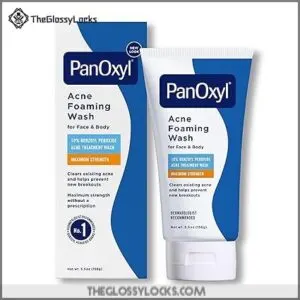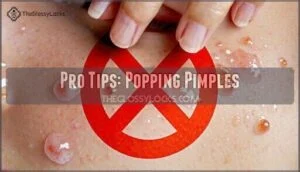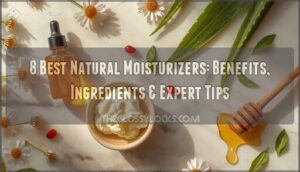This site is supported by our readers. We may earn a commission, at no cost to you, if you purchase through links.

These ingredients target the root causes: clogged pores, bacteria, and inflammation. You’ll need patience—results typically show after 6-12 weeks of consistent use.
Start with lower concentrations to avoid irritation, and always follow up with moisturizer since these treatments can dry your skin. While OTC options work for many people, severe cases might need prescription help.
The key lies in understanding which active ingredients match your specific skin needs and triggers, to effectively manage cystic acne.
Table Of Contents
- Key Takeaways
- Best Cystic Acne Treatments
- What Causes Cystic Acne?
- Active Ingredients to The Rescue
- Skincare Do’s and Don’ts
- Pro Tips: Popping Pimples
- Beyond Topicals: Oral and Injectable Treatments
- Frequently Asked Questions (FAQs)
- What gets rid of cystic acne quickly?
- Which medicine is best for cystic acne?
- What is the best supplement for cystic acne?
- What is the most effective treatment for cystic acne?
- What is the fastest way to get rid of a cystic pimple?
- What is the best routine for cystic acne?
- What is the drug of choice for cystic acne?
- Can cystic acne be cured?
- What foods make cystic acne worse?
- Does cystic acne always scar?
- Conclusion
Key Takeaways
- You’ll need consistency and patience – Start with proven ingredients like adapalene (Differin) or benzoyl peroxide, but do not expect overnight results, since effective treatment takes 6-12 weeks of daily use.
- Layer your products strategically – Use 2-3 active ingredients max to avoid skin overload; always follow with moisturizer, even on oily skin, and never skip sunscreen, since these treatments increase sun sensitivity.
- Target the root causes, not just symptoms – Focus on ingredients that unclog pores (adapalene), kill bacteria (benzoyl peroxide), and reduce inflammation (salicylic acid), rather than harsh scrubs that damage your skin barrier.
- Know when to seek professional help – If OTC treatments are not working after 12 weeks, or you are dealing with severe cystic acne, you will need prescription medications or cortisone injections from a dermatologist.
Best Cystic Acne Treatments
Cystic acne’s deep, painful nodules won’t budge with typical acne treatments, but the right over-the-counter products can make a real difference.
You’ll need targeted ingredients that work beneath the surface to tackle inflammation and prevent new cysts from forming, which is crucial for managing cystic acne.
1. Differin Acne Treatment Gel

Differin’s adapalene gel stands as the skincare game-changer you’ve been waiting for.
Your skin’s been waiting for this prescription-strength breakthrough that actually delivers results.
This FDA-approved retinoid works by regulating skin cell turnover and targeting inflammation at the follicular level, effectively preventing clogged pores before they become problematic cysts.
The gel delivers impressive results—up to 87% reduction in acne breakouts within 12 weeks of daily use.
Its water-based, fragrance-free formula won’t clog pores or irritate sensitive skin like harsher alternatives.
However, brace yourself for the initial "purge phase."
Your skin might temporarily worsen for 6-8 weeks as trapped debris surfaces.
Start with pea-sized amounts every other night, gradually increasing frequency.
Always pair with sunscreen since retinoids increase photosensitivity.
While powerful for mild-to-moderate acne, severe cystic cases often require prescription-strength treatments.
Best For: Mild-to-moderate acne sufferers looking for a proven, over-the-counter retinoid that helps prevent and treat breakouts while improving skin texture.
- FDA-approved adapalene provides prescription-strength acne treatment without a prescription
- Non-comedogenic, fragrance-free, and less irritating than many other retinoids
- Up to 87% reduction in breakouts after 12 weeks of use
- May cause an initial purge phase with worsened acne for 6-8 weeks
- Not strong enough for severe or cystic acne without additional prescription treatments
- Can increase skin sensitivity, requiring consistent sunscreen use
2. CeraVe Acne Foaming Cleanser

Beyond just another cleanser, CeraVe’s Acne Foaming Cleanser packs a serious punch against cystic acne with its 4% benzoyl peroxide formula.
This powerhouse ingredient targets acne-causing bacteria while clearing deep pore blockages that fuel those painful underground bumps.
What sets it apart? The addition of ceramides and hyaluronic acid keeps your skin barrier intact, preventing the over-drying that plagues many acne treatments.
Just remember—this cleanser can bleach your favorite towels, so stick to white ones and follow up with a gentle moisturizer.
Best For: Those with stubborn cystic or persistent acne who need effective deep cleaning without severely drying the skin.
- Clears acne quickly and prevents new breakouts, especially effective for cystic acne.
- Maintains moisture with ceramides and hyaluronic acid, keeping skin balanced.
- Gentle enough for sensitive and daily use, with noticeable results in days to weeks.
- Benzoyl peroxide may bleach colored fabrics like towels and clothing.
- Can be drying or irritating for some skin types without proper moisturizing.
- May require patch testing to avoid potential irritation, especially for those new to benzoyl peroxide.
3. PanOxyl Acne Foaming Wash 10%

When you’re battling stubborn cystic acne, PanOxyl Acne Foaming Wash 10% packs a serious punch.
This powerhouse formula contains 10% benzoyl peroxide – the strongest concentration available without a prescription.
Think of benzoyl peroxide as your skin’s personal bodyguard.
It kills acne-causing bacteria on contact while cleansing and unclogging pores across your face, chest, and back.
The antimicrobial action doesn’t mess around – it tackles existing breakouts and blocks new ones from forming.
Here’s the catch: this isn’t your everyday cleanser.
The high-strength formula can be drying, so start slow.
Use it a few times weekly, then gradually increase frequency as your skin adjusts.
Always follow with moisturizer and sunscreen.
Dermatologists recommend this product because it delivers results.
A little goes a long way, making it cost-effective for treating widespread cystic acne.
Best For: Those with stubborn or severe acne—especially cystic acne—who need a powerful, over-the-counter cleanser for face or body.
- Delivers one of the strongest OTC benzoyl peroxide treatments for noticeable results.
- Kills acne-causing bacteria and unclogs pores on face, chest, and back.
- Can simplify routine by replacing multiple products for some users.
- Strong formula may cause dryness, peeling, or irritation, especially on sensitive skin.
- Has a noticeable bleach smell upon opening.
- Not suitable for daily use for most skin types; must be used with care.
4. Neutrogena Acne Spot Treatment Gel

When stubborn acne won’t budge, Neutrogena’s Acne Spot Treatment Gel delivers targeted relief where you need it most.
This 10% benzoyl peroxide formula packs the maximum strength available without a prescription.
It’s clinically proven to shrink acne size and reduce redness within just two hours, with results continuing throughout the day.
You can apply this lightweight gel up to three times daily on cleansed skin.
The formula dries quickly without leaving heavy residue, making it perfect for daytime use under makeup or overnight treatment.
Start slowly—benzoyl peroxide can cause dryness or flaking, especially on sensitive skin.
Begin with once-daily application and pair with a gentle moisturizer to prevent irritation.
Best For: Those with acne-prone skin needing fast, targeted treatment for stubborn pimples and occasional cystic breakouts.
- Clinically proven to reduce acne size and redness in 2 hours
- Maximum strength 10% benzoyl peroxide for rapid results
- Lightweight gel absorbs quickly and works under makeup or overnight
- Can cause dryness, flaking, or irritation, especially if overused
- May not fully clear deep cystic acne or severe breakouts on its own
- Benzoyl peroxide can bleach fabrics and stain clothing
What Causes Cystic Acne?
Understanding what triggers your cystic acne can help you manage breakouts more effectively.
The main culprits include hormonal fluctuations, certain foods, stress, and genetic factors that create the perfect storm for deep, painful cysts to form, which can be influenced by genetic factors.
Food Triggers
Your diet plays a bigger role in cystic acne than you might think. Certain foods trigger inflammatory responses that worsen breakouts, while others help your skin heal and stay clear.
Dairy and acne share a well-documented connection. Skim milk contains hormones that can spike insulin levels, leading to increased oil production. Processed foods loaded with refined sugar also cause insulin spikes, creating the perfect storm for inflammation in your pores.
Here are five key dietary changes that can help calm your skin:
- Limit dairy products – especially skim milk and whey protein supplements
- Reduce sugar intake – cut back on sodas, candy, and processed snacks
- Support gut health – add probiotics through yogurt or fermented foods
- Avoid inflammatory foods – minimize refined carbs and processed meals
- Choose anti-inflammatory options – include omega-3 rich fish and antioxidant-packed berries
The gut health connection matters too. A balanced microbiome helps reduce systemic inflammation that shows up on your face.
Stress and Hormones
Your stress levels directly impact your skin’s oil production through cortisol levels and stress reduction becomes critical for managing hormonal acne.
Understanding how stress and acne connect helps you target effective cystic acne treatment approaches.
Stress can also weaken the skin’s natural barrier, making it more vulnerable to breakouts, and hormonal changes during puberty effects and cycle breakouts trigger cystic lesions, while conditions like PCOS worsen breakouts.
Active Ingredients to The Rescue
Understanding the right active ingredients can transform your cystic acne treatment from frustrating to effective.
These powerful compounds work beneath the surface to tackle inflammation, bacteria, and clogged pores that fuel those painful bumps.
Here are five game-changing ingredients for cystic acne treatment:
- Benzoyl Peroxide – Kills acne-causing bacteria while reducing inflammation.
- Adapalene – This retinoid acne cream unclogs pores and regulates cell turnover.
- Salicylic Acid – Penetrates pores to dissolve oil and dead cells.
- Sulfur – Dries excess oil and calms inflammation, making sulfur alternatives ideal for spot treatments on individual cysts.
- Niacinamide – Reduces redness and regulates sebum production.
Start with 2.5% concentrations to minimize irritation, as they’re equally effective as higher strengths for benzoyl peroxide acne control.
Adapalene benefits include preventing new cysts by targeting inflammation deep within follicles.
While less effective for deep cysts, salicylic acid acne treatments excel at preventing future breakouts.
Niacinamide effects include strengthening your skin barrier while minimizing post-acne marks.
Many treatments increase sun sensitivity, so sunscreen is essential.
Skincare Do’s and Don’ts
Three fundamental principles guide effective cystic acne treatment: consistency, gentleness, and patience. Your skincare routine shouldn’t feel like a battlefield against your skin.
Product application matters more than you think. Apply acne medications evenly across problem areas rather than spot-treating individual blemishes. This prevents new cysts from forming while addressing existing inflammation.
Gentle exfoliation through chemical exfoliants beats harsh scrubs every time. Over-scrubbing damages your skin barrier and triggers more oil production – the opposite of what you want.
Ingredient layering requires strategy. Limit yourself to 2-3 active ingredients simultaneously to avoid skin overload and irritation.
| Essential DO | Critical DON’T |
|---|---|
| Use sunscreen importance daily to prevent hyperpigmentation | Skip moisturizer thinking it’ll reduce oil production |
Hydration habits matter tremendously. Even oily, acne-prone skin needs moisture. Choose lightweight, oil-free formulas that won’t clog pores.
Remember: over the counter acne treatments need 6-8 weeks to show results. Switching products too quickly sabotages your progress. Cystic acne is often triggered by pores clogged with oil, dead cells, and bacteria.
Pro Tips: Popping Pimples
Hands-off approach protects your skin from lasting damage. Popping cystic acne creates serious extraction risks that aren’t worth the temporary relief.
- Infection control fails: Squeezing introduces bacteria deeper into tissue, causing painful secondary infections
- Scar prevention becomes impossible: Trauma from popping pimples creates permanent marks and discoloration
- Professional drainage works better: Dermatologists use sterile techniques that support proper healing process
Instead, apply warm compresses and use benzoyl peroxide treatments. These methods reduce acne inflammation without compromising your skin’s integrity or creating lasting acne scars.
To further protect your skin, it’s important to maintain skin hydration with a suitable moisturizer.
Beyond Topicals: Oral and Injectable Treatments
When stubborn cystic acne doesn’t respond to over-the-counter treatments, prescription oral medications and cortisone injections become your next line of defense. These powerful interventions target the root causes that topical products can’t reach.
Oral isotretinoin stands as the gold standard for severe cystic acne treatment, dramatically reducing oil production and inflammation. Spironolactone benefits include blocking hormones that trigger breakouts, particularly effective for women. Birth control pills offer another hormonal approach, while antibiotics efficacy lies in their anti-inflammatory properties rather than just bacterial control.
| Treatment Type | Primary Action |
|---|---|
| Oral Isotretinoin | Reduces oil production |
| Spironolactone | Blocks acne-causing hormones |
| Birth Control | Regulates hormone levels |
| Cortisone Shots | Shrinks cysts rapidly |
For immediate relief, cortisone injections deliver targeted medication directly into cysts, reducing inflammation within 24-48 hours. These injectables work faster than any topical solution, making them ideal for special events or persistent lesions. Your dermatologist can determine which oral medications or cortisone shots best suit your specific needs.
Frequently Asked Questions (FAQs)
What gets rid of cystic acne quickly?
You’ll need professional help for fast cystic acne relief. Dermatologists can inject cortisone directly into cysts, reducing inflammation within 24-48 hours—that’s your quickest option for stubborn breakouts.
Which medicine is best for cystic acne?
Like traversing a labyrinth, treating cystic acne requires powerful prescription medications. Isotretinoin (Accutane) is the gold standard, while oral antibiotics, spironolactone, and topical tretinoin offer effective alternatives for persistent cases.
What is the best supplement for cystic acne?
Zinc is the top supplement for cystic acne, with studies showing 400-600mg daily for 12 weeks reduces inflammation substantially.
DIM, vitamin B5, and probiotics also support healthier skin by addressing hormonal imbalances and gut health.
What is the most effective treatment for cystic acne?
Breaking through cystic acne‘s fortress requires professional firepower. You’ll need dermatologist-prescribed treatments like isotretinoin, cortisone injections, or oral antibiotics—over-the-counter options simply can’t penetrate deep enough.
What is the fastest way to get rid of a cystic pimple?
Professional cortisone injections offer the fastest relief, reducing cystic inflammation within 24-48 hours.
While waiting for dermatologist care, apply ice wrapped in cloth for 10-15 minutes to minimize swelling and pain.
What is the best routine for cystic acne?
Picture your skin as a battlefield where deep, angry cysts wage war beneath the surface.
You’ll need a gentle cleanser with salicylic acid, followed by adapalene gel nightly, plus consistent moisturizing to calm inflammation effectively.
What is the drug of choice for cystic acne?
For severe cystic acne, isotretinoin (formerly Accutane) is the gold standard drug of choice.
It’s highly effective because it targets all underlying causes of acne formation, providing long-term remission for most patients.
Can cystic acne be cured?
Cystic acne can’t be completely "cured," but it’s highly treatable and manageable. You’ll likely see significant improvement with proper medical treatment, though flare-ups may occasionally return throughout life.
What foods make cystic acne worse?
Like opening Pandora’s box, certain foods can trigger inflammatory cascades that worsen your cystic breakouts.
Dairy products, high-glycemic foods, processed snacks, and excess sugar fuel inflammation and hormonal fluctuations that aggravate cystic acne formation, leading to hormonal imbalances.
Does cystic acne always scar?
No, cystic acne doesn’t always scar, but it’s more likely to leave marks than regular pimples. Early treatment and avoiding picking dramatically reduce your scarring risk.
Conclusion
Finding the best over the counter treatments for cystic acne can feel like searching for a needle in a haystack – but it doesn’t have to be overwhelming.
You’ve got solid options that actually work when used consistently, such as Differin’s adapalene which targets deep clogs, while benzoyl peroxide washes eliminate bacteria causing those painful bumps.
Remember, patience pays off with these treatments, so stick to your routine for at least twelve weeks, moisturize religiously, and don’t pick at your skin – no matter how tempting it gets!
- https://www.nbcnews.com/select/shopping/best-cystic-acne-treatments-ncna1303082
- https://www.realself.com/news/skin-care-ingredients-treating-cystic-acne
- https://seekerdermatology.com/acne-treatment-options/
- https://onlinedoctor.superdrug.com/cystic-acne.html
- https://www.goodrx.com/conditions/acne/acne-treatment-guide








